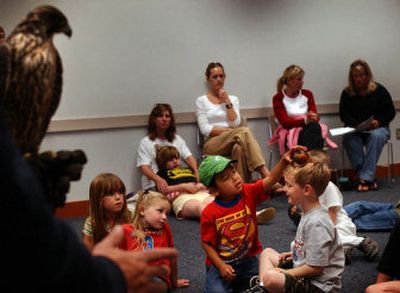Read to your pet

What better way to teach kids to expand their reading ability and learn social skills than by reading about pets? A visit to your local children’s bookstore or the children’s section of the library will show dozens of children’s books about animals, pets in particular, which bring these benefits.
Thom Barthelmess, youth services coordinator for the Spokane County Library District, has ideas about why kids love reading about animals.
“I think for little kids, one of the first things they learn is the sounds barnyard animals make, and animals are easy to identify with and imitate,” he said. “Also, a lot of kids have pets. When they lose a pet it’s probably one of their first experiences with grief. And by the same token, having a pet is one of their first experiences with love and responsibility so there’s an emotional resonance with animals.”
Marilyn Carpenter, professor of children’s literature in the College of Education and Human Development at Eastern Washington University, agrees.
“One of my students has twin boys, 3-year-olds, and she just got them a puppy,” said Carpenter. “The doggie is someone to tell special secrets to, someone to play with, and, most importantly, to love unconditionally. Parents use pets to teach responsibility. Children use them for fun.”
Susan Peterson, owner of Children’s Corner Books and Toys in River Park Square, believes parents can build on the skills their child has begun to learn in school by encouraging continued reading about animals.
“I think parents are looking for a way to get children interested in reading,” she said. “Most second graders have to do animal reports for their classes.”
Peterson should know. For six years she helped students as a librarian at the North Spokane Library, and she’s always been a voracious reader herself.
“I can remember my mom taking me to the library as a kid. She started a good habit,” said Peterson.
Parents today are still trying the same tactic but often feel overwhelmed by the prospect of taking their energetic children to visit the library, said Carpenter.
“I spoke to parents at one of the cooperative nursery schools last winter,” she said. “They told me one of their chief difficulties is trying to find books in the library while controlling their 2-year-old. The solution is to go alone and bring the books home.”
Carpenter suggested the following rule of thumb: Know first what your child’s interest is, then go to the library and ask for expert advice.
“I remember my friend had a little boy, and when he was 4, he had captured all of these insects and kept them in a cigar box,” she recalled. “His mother went to the library and checked out books about insects so she could read to him. He learned their scientific names and their habits – everything – because he was interested in that topic.”
Carpenter takes her own advice in her classroom at Eastern.
“My first goal is to try and teach education students the joy of reading,” she said. “We’ve lost the pure pleasure of reading in our schools.”
Barthelmess points to a few animal classics as a starting point for parents.
“‘Charlotte’s Web’ is certainly one that everyone is aware of,” he said. “Then there are books like ‘Old Yeller,’ ‘Sounder,’ and ‘Where the Red Fern Grows’ that are sad but have captured our imagination and that kids continue to read year after year.”
Peterson said nostalgia plays a big part in selecting the classics. “These are books the parents read,” she said. “Young girls are often fascinated by horses, and young boys love dogs and adventure stories, so ‘Black Beauty’ and Jack London’s Yukon stories like ‘Call of the Wild’ and ‘White Fang’ seem timeless.”
Barthelmess also encourages families who are considering pet adoption to use animal books for research.
“Clearly there’s research to be done when you are acquiring a pet or when you are caring for one. Libraries and bookstores are places where there are books to do research on different breeds,” he said. “You can learn how much time the animal will take, how to groom it, and much more.”
Peterson said there is another reason to consider pet books for kids. “They can introduce children to the concept of responsibility.”
If a family already owns a pet, there are books designed to be read to the animal. “‘Stories to Read to Your Cat’ and ‘Stories to Read to Your Dog’ are great for practice reading aloud,” said Carpenter.